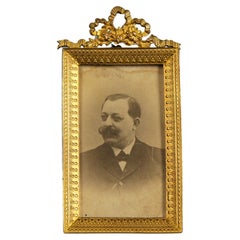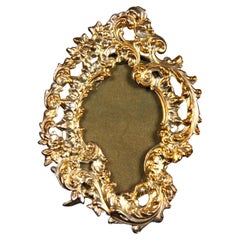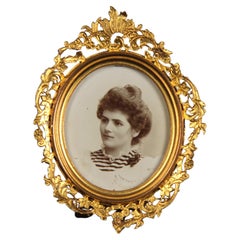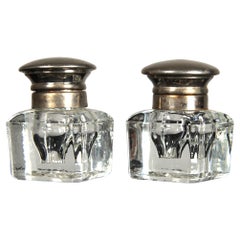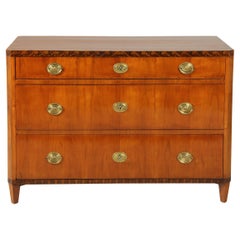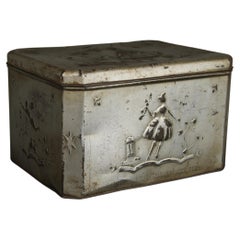Galerie Balbach
to
26
332
216
175
104
50
42
30
30
28
17
12
12
10
9
9
9
9
8
7
7
7
4
3
3
3
3
3
3
2
2
2
2
2
2
1
1
1
1
10
2
2
1
1
Antique Victorian Picture Frame, France, 1880s, 3, 5 x 6, 5 cm
Located in Greven, DE
Beautiful victorian picture frame from France, circa 1880s.
French picture frames from the Victorian era are an expression of an epoch that was known for its decorative wealth and a...
Category
Early 20th Century French Victorian Picture Frames
Materials
Brass
Antique Victorian Picture Frame, France, 1900s, 3 x 5 cm
Located in Greven, DE
Beautiful victorian picture frame from France, circa 1900s.
French picture frames from the Victorian era are an expression of an epoch that was known for its decorative wealth and a...
Category
Early 20th Century French Victorian Picture Frames
Materials
Brass
Antique Victorian Picture Frame, France, 1880s, 4 x 5 cm
Located in Greven, DE
Beautiful victorian picture frame from France, circa 1880s.
French picture frames from the Victorian era are an expression of an epoch that was known for its decorative wealth and a...
Category
Antique Late 19th Century French Victorian Picture Frames
Materials
Brass
Pair Of Antique Inkwells, Glass and Silvered, Circa 1880s
Located in Greven, DE
Pair of antique glass inkwells with silvered lids, France, circa 1880s.
Category
Antique 1880s Late Victorian Inkwells
Materials
Silver
Early 19th Century Biedermeier Chest of Drawers, Cherry, Munich circa 1815
Located in Greven, DE
South German Biedermeier chest of drawers
Bavaria (Munich)
Cherry
Biedermeier circa 1815
Dimensions: H x W x D: 83 x 117 x 58 cm
Description:
Piece of furniture from the early Bi...
Category
Antique 1810s German Biedermeier Commodes and Chests of Drawers
Materials
Cherry
Large 1930s Tin Box "Kaffee-Schilling", Schilling & Sohn Bremen Vintage Tin Can
Located in Greven, DE
Antique Tin Box from "Kaffee-Schilling" Bremen.
Category
20th Century German Decorative Boxes
Materials
Tin
Antique French Tin Cans, Cookie Tins, Art Deco, Set of 3, 1920s 1930s, France
Located in Greven, DE
A Set of 3 antique tin cans from France, 1920 s / 1930s.
Category
Vintage 1920s French Decorative Boxes
Materials
Tin
20th Century Owls Bookends
Located in Greven, DE
Two carved owls as bookends, 1980s
Category
20th Century Bookends
Materials
Wood
1950s Italian Lifesize Ceramic Poodle
Located in Greven, DE
Life-size and detailed ceramic poodle. Glazed white with colored eyes, muzzle and collar.
Inscribed on the underside: Made in Italy 7382.
Excellent, clean condition with no damage.
Category
Mid-20th Century Italian Animal Sculptures
Materials
Ceramic
German Biedermeier Chest of Drawers, Walnut, circa 1825
Located in Greven, DE
Biedermeier Chest of Drawers
Southern Germany
Walnut
Biedermeier around 1825
Dimensions: H x W x D: 84 x 106 x 55 cm
Description:
Three-tier piece of furniture standing on solid b...
Category
Antique 1820s German Biedermeier Commodes and Chests of Drawers
Materials
Walnut
Convolute Of 13 Antique Glasses, France, 19th And 20th Century
Located in Greven, DE
A beautiful convolute of 13 antique and unique glasses, France, late 19th and early 20th century.
Category
Early 20th Century French Glass
Materials
Glass
Pair Of Handpainted Glasses, Mid-20th Century, France, 15 cm
Located in Greven, DE
A beautiful pair of handpainted glasses, France, Mid-20th Century.
Category
Late 20th Century French Glass
Materials
Glass
Large Early 19th Century Empire Chest Of Drawers, Mahogany, Ormolu, Paris, 1810
Located in Greven, DE
Large Empire chest of drawers
Paris
Mahogany
Early 19th century
Dimensions: H x W x D: 97 x 136 x 68 cm
Description:
The architecturally designed front of the chest of drawers is divided into three zones.
A plinth connected to the floor forms the lower section, on which two sturdy columns rest, supporting the upper section, which houses a large drawer. Three further drawers are housed in the centre section of the chest of drawers, which recedes behind the columns.
A black granite top forms the upper end.
The drawers, the back panel and the body are made of oak, except for the panels in the side walls.
The top section with the ledge drawer is connected to the body with wooden wedges and can be removed for transport. This detail can be clearly seen in one of the photos.
Exquisitely beautiful mahogany veneer, horizontally mirrored on the drawers at the height of the key entrances, enlivens the smooth surfaces on which the lavishly gilded bronzes unfold their effect.
Some of the very finely crafted fittings can also be found on Empire furniture by Jacob...
Category
Antique Early 19th Century French Empire Commodes and Chests of Drawers
Materials
Bronze, Ormolu
Rare Handpainted Villeroy & Boch Glass, 1920s, France, 15 cm
Located in Greven, DE
A beautiful handpainted glass, France, circa 1920s.
Stamped by Villeroy & Boch.
At the turn of the 20th century, the French culture of fine dining and socialising flourished, leadin...
Category
Early 20th Century French Glass
Materials
Glass
Late 18th Century Louis XVI Corner Cabinet with Marquetry, Germany, circa 1790
Located in Greven, DE
Louis XVI corner cabinet with marquetry
Southern Germany
Walnut, maple
Classicism around 1790
Dimensions: H x W x D: 222 x 98 x 55 cm, side depth: 66 cm
Description:
Slim and well...
Category
Antique Late 18th Century German Louis XVI Corner Cupboards
Materials
Walnut
19th Century Small, Single-Door Biedermeier Wardrobe, Austria, circa 1830
Located in Greven, DE
Small Biedermeier Wardrobe
Austria
Walnut
Biedermeier circa 1830
Dimensions: H x W x D: 165 x 91 x 45 cm
Description:
Very small, single-door cabinet from the Austrian Biedermeier...
Category
Antique 1830s Austrian Biedermeier Wardrobes and Armoires
Materials
Walnut
19th Century Biedermeier Chair with Ink Painting, Northern Germany, circa 1820
Located in Greven, DE
Biedermeier Chair with Ink Painting
Northern Germany
Birch
Biedermeier circa 1820
Dimensions: H x W x D: 84 x 42 x 47 cm Seat height: 48 cm
Description:
Chair made of solid birch,...
Category
Antique 1820s German Biedermeier Chairs
Materials
Birch
Mid 19th Century High-Adjustable Architect's Table, Mahogany, France, circa 1850
Located in Greven, DE
High-Adjustable Architect's Table
France
Mahogany
Mid 19th century
Dimensions: H x W x D: 79 x 93 x 56 cm, height adjustment: 79 - 120 cm
Description:
Rare writing and drawing tab...
Category
Antique Mid-19th Century French Louis Philippe Desks and Writing Tables
Materials
Mahogany
1830s French Table Clock, signed by LESIEUR á Paris, Pendule "Virgil the Poet"
By Lesieur
Located in Greven, DE
Pendule - Virgil the Poet
Paris
Bronze, marble
around 1830
Dimensions: H x W x D: 61 x 43 x 17 cm
Description:
Large and, at around 30 kg, very heavy French bronze clock from the ...
Category
Antique 1830s French Restauration Table Clocks and Desk Clocks
Materials
Siena Marble, Bronze
Biedermeier Chest, Secretary or Cabinet, Walnut, Southern Germany, circa 1830
Located in Greven, DE
Biedermeier chest of drawers with writing drawer and raised compartment
Southern Germany
Walnut, birch
Biedermeier around 1830
Dimensions: H x W x D: 191 x 126 x 64 cm
Description...
Category
Antique 1830s German Biedermeier Buffets
Materials
Walnut
Antique Boule Ball "6", Pétanque, 1880s, France, Craftsmanship
Located in Greven, DE
Beautiful, unique Boule ball, France, late 19th Century.
In the 19th century, the manufacture of boules balls underwent significant development in France as the game of boules, part...
Category
Antique Late 19th Century French Late Victorian Antiquities
Materials
Metal, Brass
Antique Boule Ball With Flower Decor, Pétanque, 1880s, France, Craftsmanship
Located in Greven, DE
Beautiful, unique Boule ball, France, late 19th Century.
In the 19th century, the manufacture of boules balls underwent significant development in France as the game of boules, part...
Category
Antique Late 19th Century French Late Victorian Antiquities
Materials
Metal, Brass
Antique Boule Ball "J P", Pétanque, 1880s, France, Craftsmanship
Located in Greven, DE
Beautiful, unique Boule ball, France, late 19th Century.
In the 19th century, the manufacture of boules balls underwent significant development in France as the game of boules, part...
Category
Antique Late 19th Century French Late Victorian Antiquities
Materials
Metal, Brass
Antique Boule Ball Brass Decor, Pétanque, 1880s, France, Craftsmanship
Located in Greven, DE
Beautiful, unique Boule ball, France, late 19th Century.
In the 19th century, the manufacture of boules balls underwent significant development in France as the game of boules, part...
Category
Antique Late 19th Century French Late Victorian Antiquities
Materials
Metal, Brass
Antique Boule Ball "C" With Star Decor, Pétanque, 1880s, France, Craftsmanship
Located in Greven, DE
Beautiful, unique Boule ball, France, late 19th Century.
In the 19th century, the manufacture of boules balls underwent significant development in France as the game of boules, part...
Category
Antique Late 19th Century French Late Victorian Antiquities
Materials
Metal, Brass
Antique Boule Ball With Star Decor And C, Pétanque, 1880s, France, Craftsmanship
Located in Greven, DE
Beautiful, unique Boule ball, France, late 19th Century.
In the 19th century, the manufacture of boules balls underwent significant development in France as the game of boules, part...
Category
Antique Late 19th Century French Late Victorian Antiquities
Materials
Metal, Brass
Antique Boule Ball "D F", Pétanque, 1880s, France, Craftsmanship
Located in Greven, DE
Beautiful, unique Boule ball, France, late 19th Century.
In the 19th century, the manufacture of boules balls underwent significant development in France as the game of boules, part...
Category
Antique Late 19th Century French Late Victorian Antiquities
Materials
Metal, Brass
Antique Boule Ball "P A", Pétanque, 1880s, France, Craftsmanship
Located in Greven, DE
Beautiful, unique Boule ball, France, late 19th Century.
In the 19th century, the manufacture of boules balls underwent significant development in France as the game of boules, part...
Category
Antique Late 19th Century French Late Victorian Antiquities
Materials
Metal
Antique Boule Ball, Pétanque, 1880s, France, Craftsmanship
Located in Greven, DE
Beautiful, unique Boule ball, France, late 19th Century.
In the 19th century, the manufacture of boules balls underwent significant development in France as the game of boules, part...
Category
Antique Late 19th Century French Late Victorian Antiquities
Materials
Metal
Antique Boule Ball "62", Pétanque, 1880s, France, Craftsmanship
Located in Greven, DE
Beautiful, unique Boule ball, France, late 19th Century.
In the 19th century, the manufacture of boules balls underwent significant development in France as the game of boules, part...
Category
Antique Late 19th Century French Late Victorian Antiquities
Materials
Metal
Antique Boule Ball "17", Pétanque, 1880s, France, Craftsmanship
Located in Greven, DE
Beautiful, unique Boule ball, France, late 19th Century.
In the 19th century, the manufacture of boules balls underwent significant development in France as the game of boules, part...
Category
Antique Late 19th Century French Late Victorian Antiquities
Materials
Metal
Antique Boule Ball "B", Pétanque, 1880s, France, Craftsmanship
Located in Greven, DE
Beautiful, unique Boule ball, France, late 19th Century.
In the 19th century, the manufacture of boules balls underwent significant development in France as the game of boules, part...
Category
Antique Late 19th Century French Late Victorian Antiquities
Materials
Metal
Complete Set Of Antique Boule Balls, 8 Pieces, Pétanque, 1880s, France
Located in Greven, DE
Complete Boule ball set of 8 pieces, France, late 19th Century.
In the 19th century, the manufacture of boules balls underwent significant development in France as the game of boule...
Category
Antique Late 19th Century French Late Victorian Antiquities
Materials
Metal
Large Set Of Antique Boule Balls, 13 Pieces, Pétanque, 1880s, France
Located in Greven, DE
Large Boule ball set of 13 pieces, France, late 19th Century.
Unrestored, original condition with signs of age and use.
In the 19th century, the manufacture of boules balls underwen...
Category
Antique Late 19th Century French Late Victorian Antiquities
Materials
Metal, Copper, Steel
Pair of French Candlesticks, Brass, 20th Century
Located in Greven, DE
Great pair of brass candlesticks with adjustable inlay.
France, 20th century.
Category
20th Century French Candlesticks
Materials
Brass
19th Century French Music Stand with Candle Holders
Located in Greven, DE
Antique duet music stand
France
Mahogany
second half of the 19th century
Dimensions:
Width of the music stand: 43 cm, height adjustment: from 108 cm to 151 cm
The piano stool show...
Category
Antique Late 19th Century French Music Stands
Materials
Mahogany
Antique Picture Frame Shamrock, Silver Plated, France, 10 x 14 cm
Located in Greven, DE
Beautiful antique picture frame from France, around 1910, Art Nouveau.
Zinc Casting Silver Plated.
Picture size: 10 x 14 cm.
Category
Early 20th Century French Art Nouveau Picture Frames
Materials
Zinc
Antique Picture Frame, France, Zinc Cast, Art Nouveau, 10 x 13 cm
Located in Greven, DE
Beautiful antique picture frame from France, around 1910, Art Nouveau.
Zinc Casting.
Picture size: 10 x 13 cm.
Category
Early 20th Century French Art Nouveau Picture Frames
Materials
Zinc
English Bracket Clock with Silver Plated Dial, London, circa 1800
By Johnson
Located in Greven, DE
Bracket Clock
London
wood, brass
around 1800
Dimensions: H x W x D: 46 x 27 x 17 cm
Description:
English bracket clock in an ebonised "bell-top" wooden case with a carrying handle...
Category
Antique Early 19th Century English Table Clocks and Desk Clocks
Materials
Brass
Pair Of Antique Picture Frames, Bordeaux Red Velvet, France, 1880s, 5 x 7 cm
Located in Greven, DE
Unique pair of victorian picture frames from France, circa 1880s.
Beautiful frames with red velvet border.
French picture frames from the Victorian era are an expression of an epoch...
Category
Antique Late 19th Century French Victorian Picture Frames
Materials
Brass
Antique Victorian Picture Frame, France, 1880s, 12 x 20 cm
Located in Greven, DE
Beautiful victorian picture frame from France, circa 1880s.
French picture frames from the Victorian era are an expression of an epoch that was known for its decorative wealth and a...
Category
Antique Late 19th Century French Victorian Picture Frames
Materials
Brass
Antique Gutta-Percha Picture Frame, France, 1880s, 9 x 6 cm
Located in Greven, DE
Beautiful victorian picture frame from France circa 1880.
Made of the particular material Gutta-Percha.
Gutta percha, a natural material, experienced a remarkable peak in the 19th c...
Category
Antique Late 19th Century French Late Victorian Picture Frames
Materials
Other
Irénée Rochard Greyhound Sculpture, Silver-Plated, Art Deco, France
By Irénée Rochard
Located in Greven, DE
Sculpture in silver-plated cast zinc by Irenee Rochard, France, Art Deco.
Signed “Rochard” on the pedestal.
Irénée Rochard (1906-1984) was a French sculptor who made a name for hims...
Category
Vintage 1940s French Art Deco Animal Sculptures
Materials
Zinc, Silver Plate
Antique Victorian Picture Frame Enameled Iris, France, 1880s, 10 x 16 cm
Located in Greven, DE
Beautiful victorian picture frame from France, circa 1880s.
The top and feet are decorated with a colourful enameled iris.
French picture frames from the Victorian era are an expres...
Category
Antique Late 19th Century French Victorian Picture Frames
Materials
Brass
Antique Victorian Picture Frame Turquois Bow, France, 1880s, 10 x 16 cm
Located in Greven, DE
Beautiful victorian picture frame from France, circa 1880s.
The top is decorated with an enameled turquois bow.
French picture frames from the Victorian era are an expression of an ...
Category
Antique Late 19th Century French Victorian Picture Frames
Materials
Brass
Antique Victorian Picture Frame, France, 1880s, 10 x 14 cm
Located in Greven, DE
Beautiful victorian picture frame from France, circa 1880s.
French picture frames from the Victorian era are an expression of an epoch that was known for its decorative wealth and a...
Category
Antique Late 19th Century French Victorian Picture Frames
Materials
Brass
Antique Brass Bamboo Picture Frame, France, 1880s, 10 x 14 cm
Located in Greven, DE
Beautiful picture frame from France, circa 1880s. Brass in a bamboo design.
French picture frames from the Victorian era are an expression of an epoch that was known for its decorat...
Category
Antique Late 19th Century French Victorian Picture Frames
Materials
Brass
Antique Victorian Picture Frame, Bronze Dorée, France, 1880s, 6 x 9 cm
Located in Greven, DE
Beautiful picture frame from France, circa 1880s.
French picture frames from the Victorian era are an expression of an epoch that was known for its decorative wealth and appreciatio...
Category
Antique Late 19th Century French Victorian Picture Frames
Materials
Brass
Late 18th Century English Longcase Clock with Moonphases, Manchester, circa 1780
Located in Greven, DE
Late 18th Century English Grandfather Clock with Moonphases
England (Manchester)
Mahogany
second half of 18th century
Dimensio...
Category
Antique Late 18th Century English Grandfather Clocks and Longcase Clocks
Materials
Mahogany
Scottish Longcase Clock made by William Spark, Aberdeen, circa 1820
Located in Greven, DE
George III grandfather clock with silver-plated dial
Scotland (Aberdeen)
Mahogany
George III around 1820
Dimensions: H x W x D: 222 x 47 x 23 cm
Description:
Beautiful antique Scottish grandfather...
Category
Antique 1820s Scottish George III Grandfather Clocks and Longcase Clocks
Materials
Mahogany
Late 18th Century German Louis XVI Top Mounted Chest with Marquetry, circa 1780
Located in Greven, DE
Louis XVI top-mounted furniture in patina condition
Germany (Saxony)
Satinwood, mahogany and others
Louis XVI around 1780
Dimensions: H x W x D: 203 x 124 x 63 cm
Description:
Che...
Category
Antique 1780s German Louis XVI Buffets
Materials
Wood
Antique Boule Ball "7", Pétanque, 1880s, France, Craftsmanship
Located in Greven, DE
Beautiful, unique Boule ball, France, late 19th Century.
In the 19th century, the manufacture of boules balls underwent significant development in France as the game of boules, particularly the pétanque variant, gained in popularity. The manufacture of boules balls during this period was a manual process that required expertise, precision and love to detail.
In the late 19th and early 20th centuries, particularly in rural areas of France and other Mediterranean regions, olive wood was a commonly used source of material for making boules balls. This was not only due to the availability of the material, but also to the outstanding properties of olive wood, which was characterized by hardness, strength and a rich grain.
First, the olive wood was carefully selected and shaped into raw balls, which were then sanded to the desired size and shape. The nails were then hammered into the balls one by one, making sure that they were evenly distributed and firmly anchored. Finally, the spheres were polished and coated with a protective varnish to enhance their natural beauty and protect them from the elements.
The use of nails to decorate and reinforce olive wood boules was a traditional practice that not only gave the ball a rustic aesthetic, but also improved its durability and contributed to customization. Many balls were made according to the specific requirements and preferences of the players. Nails were driven at regular intervals around the ball, with each nail hole precisely placed so as not to affect the balance and weight distribution of the ball. These nails not only served as a decorative element, but also helped to strengthen the structure of the ball and make it more resistant to the hard knocks and wear and tear during play. Individual engravings or decorations were often applied to the balls to make them unique and identify the player.
Antique boules...
Category
Antique Late 19th Century French Late Victorian Antiquities
Materials
Metal
Antique Boule Ball "G", Pétanque, 1880s, France, Craftsmanship
Located in Greven, DE
Beautiful, unique Boule ball, France, late 19th Century.
In the 19th century, the manufacture of boules balls underwent significant development in France as the game of boules, particularly the pétanque variant, gained in popularity. The manufacture of boules balls during this period was a manual process that required expertise, precision and love to detail.
In the late 19th and early 20th centuries, particularly in rural areas of France and other Mediterranean regions, olive wood was a commonly used source of material for making boules balls. This was not only due to the availability of the material, but also to the outstanding properties of olive wood, which was characterized by hardness, strength and a rich grain.
First, the olive wood was carefully selected and shaped into raw balls, which were then sanded to the desired size and shape. The nails were then hammered into the balls one by one, making sure that they were evenly distributed and firmly anchored. Finally, the spheres were polished and coated with a protective varnish to enhance their natural beauty and protect them from the elements.
The use of nails to decorate and reinforce olive wood boules was a traditional practice that not only gave the ball a rustic aesthetic, but also improved its durability and contributed to customization. Many balls were made according to the specific requirements and preferences of the players. Nails were driven at regular intervals around the ball, with each nail hole precisely placed so as not to affect the balance and weight distribution of the ball. These nails not only served as a decorative element, but also helped to strengthen the structure of the ball and make it more resistant to the hard knocks and wear and tear during play. Individual engravings or decorations were often applied to the balls to make them unique and identify the player.
Antique boules...
Category
Antique Late 19th Century French Late Victorian Antiquities
Materials
Metal
Antique Boule Ball "G", Pétanque, 1880s, France, Craftsmanship
Located in Greven, DE
Beautiful, unique Boule ball, France, late 19th Century.
In the 19th century, the manufacture of boules balls underwent significant development in France as the game of boules, particularly the pétanque variant, gained in popularity. The manufacture of boules balls during this period was a manual process that required expertise, precision and love to detail.
In the late 19th and early 20th centuries, particularly in rural areas of France and other Mediterranean regions, olive wood was a commonly used source of material for making boules balls. This was not only due to the availability of the material, but also to the outstanding properties of olive wood, which was characterized by hardness, strength and a rich grain.
First, the olive wood was carefully selected and shaped into raw balls, which were then sanded to the desired size and shape. The nails were then hammered into the balls one by one, making sure that they were evenly distributed and firmly anchored. Finally, the spheres were polished and coated with a protective varnish to enhance their natural beauty and protect them from the elements.
The use of nails to decorate and reinforce olive wood boules was a traditional practice that not only gave the ball a rustic aesthetic, but also improved its durability and contributed to customization. Many balls were made according to the specific requirements and preferences of the players. Nails were driven at regular intervals around the ball, with each nail hole precisely placed so as not to affect the balance and weight distribution of the ball. These nails not only served as a decorative element, but also helped to strengthen the structure of the ball and make it more resistant to the hard knocks and wear and tear during play. Individual engravings or decorations were often applied to the balls to make them unique and identify the player.
Antique boules...
Category
Antique Late 19th Century French Late Victorian Antiquities
Materials
Metal
Pair of Louis XVI Style Dutch Chinoiserie Secretary and High Chest
Located in Greven, DE
Pair of chinoiserie furniture - secretary and chiffonier
The Netherlands
Satinwood and others, lacquered panels
around 1890
Dimensions: H x W x D: 130 x 63 x 39 cm
Description:
Ve...
Category
Antique Late 19th Century Dutch Secretaires
Materials
Satinwood
Antique Boule Ball "G", "J", Pétanque, 1880s, France, Craftsmanship
Located in Greven, DE
Beautiful, unique Boule ball, France, late 19th Century.
Decorated with the initials "G" and "J".
In the 19th century, the manufacture of boules balls underwent significant developm...
Category
Antique Late 19th Century French Late Victorian Antiquities
Materials
Olive
Pair Of Antique Boule Balls "G", Pétanque, 1880s, France, Craftsmanship
Located in Greven, DE
Beautiful, unique Boule ball pair, France, late 19th Century.
In the 19th century, the manufacture of boules balls underwent significant development in France as the game of boules,...
Category
Antique Late 19th Century French Late Victorian Antiquities
Materials
Olive
Antique Boule Balls Set "9", Pétanque, 1880s, France, Craftsmanship
Located in Greven, DE
Beautiful, unique Boule set of three Boule balls and one target ball, France, late 19th century.
In the 19th century, the manufacture of boules balls underwent significant development in France as the game of boules, particularly the pétanque variant, gained in popularity. The manufacture of boules balls during this period was a manual process that required expertise, precision and love to detail.
In the late 19th and early 20th centuries, particularly in rural areas of France and other Mediterranean regions, olive wood was a commonly used source of material for making boules balls. This was not only due to the availability of the material, but also to the outstanding properties of olive wood, which was characterized by hardness, strength and a rich grain.
First, the olive wood was carefully selected and shaped into raw balls, which were then sanded to the desired size and shape. The nails were then hammered into the balls one by one, making sure that they were evenly distributed and firmly anchored. Finally, the spheres were polished and coated with a protective varnish to enhance their natural beauty and protect them from the elements.
The use of nails to decorate and reinforce olive wood boules was a traditional practice that not only gave the ball a rustic aesthetic, but also improved its durability and contributed to customization. Many balls were made according to the specific requirements and preferences of the players. Nails were driven at regular intervals around the ball, with each nail hole precisely placed so as not to affect the balance and weight distribution of the ball. These nails not only served as a decorative element, but also helped to strengthen the structure of the ball and make it more resistant to the hard knocks and wear and tear during play. Individual engravings or decorations were often applied to the balls to make them unique and identify the player.
Antique boules...
Category
Antique Late 19th Century French Late Victorian Antiquities
Materials
Olive
Antique Boule Set, Boule Balls, Pétanque, 1880s, France, Craftsmanship
Located in Greven, DE
Beautiful, unique Boule set of three Boule balls and one target ball, France, late 19th Century.
Diameter 8,5 cm.
Fantastic colour and patina!
In the 19th century, antique metal boules balls experienced a renaissance that took the game of boules to a new level.
These ornately crafted balls were not only instruments of the game, but also symbols of elegance and sophistication in leisure activities.
Made from high-quality metals such as steel or brass, Boule balls were forged and polished by skilled craftsmen to ensure a smooth and even surface.
The antique boules...
Category
Antique Late 19th Century French Late Victorian Antiquities
Materials
Metal
Antique Boule Balls Set "B", Pétanque, 1880s, France, Craftsmanship
Located in Greven, DE
Beautiful, unique Boule set of three Boule balls, France, late 19th Century.
In the 19th century, the manufacture of boules balls underwent significant development in France as the game of boules, particularly the pétanque variant, gained in popularity. The manufacture of boules balls during this period was a manual process that required expertise, precision and love to detail.
In the late 19th and early 20th centuries, particularly in rural areas of France and other Mediterranean regions, olive wood was a commonly used source of material for making boules balls. This was not only due to the availability of the material, but also to the outstanding properties of olive wood, which was characterized by hardness, strength and a rich grain.
First, the olive wood was carefully selected and shaped into raw balls, which were then sanded to the desired size and shape. The nails were then hammered into the balls one by one, making sure that they were evenly distributed and firmly anchored. Finally, the spheres were polished and coated with a protective varnish to enhance their natural beauty and protect them from the elements.
The use of nails to decorate and reinforce olive wood boules was a traditional practice that not only gave the ball a rustic aesthetic, but also improved its durability and contributed to customization. Many balls were made according to the specific requirements and preferences of the players. Nails were driven at regular intervals around the ball, with each nail hole precisely placed so as not to affect the balance and weight distribution of the ball. These nails not only served as a decorative element, but also helped to strengthen the structure of the ball and make it more resistant to the hard knocks and wear and tear during play. Individual engravings or decorations were often applied to the balls to make them unique and identify the player.
Antique boules...
Category
Antique Late 19th Century French Late Victorian Antiquities
Materials
Olive
